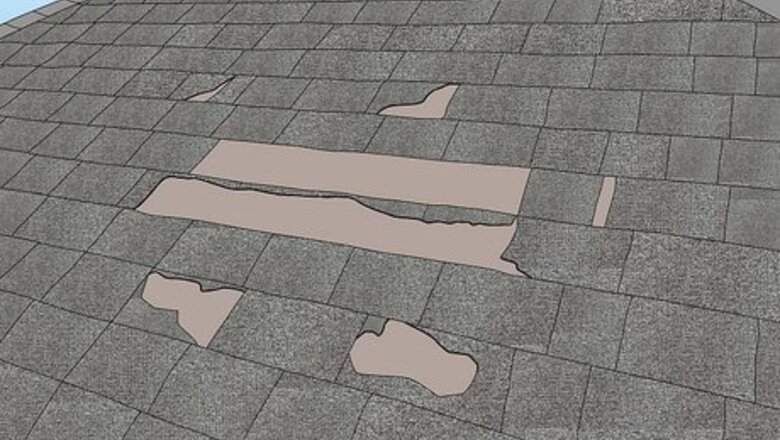
views
Assessing the Roof Damage

Find the point of damage on the roof. Use a ladder to reach your roof. If your roof is too steep to stand on, examine it from the ladder instead. Look for damaged roof tiles and scattered debris. Examine the entire roof carefully. There may be more than one section where your roof is damaged. Alternatively, go to your attic and examine the roof. Large water stains on the wood of the roof are tell-tale signs of damage.

Measure the size of the damage. Carefully get onto your roof if you can. Kneel down by the damage and unroll a tape measure. Measure the precise dimensions of the damage. Remember to measure all points of damage. If you don't know the dimensions of your roof, now is a good time to note them down for later.
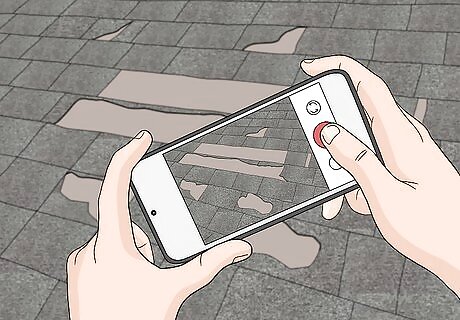
Take lots of pictures of the damage. With your phone or a camera, take as many pictures as you can of the damage. By having evidence of the damage you should have an easier time working with your home insurance if you have it. Having pictures of the damage also means you know how large a tarp you need in the hardware store.

Purchase a suitable tarp. Most hardware stores will sell a variety of tarp sizes. Generally, it's better to make sure the tarp is bigger than what you need than smaller. Most tarps cover the majority of a roof, but to be safe, measure the size of the damage and make sure your purchased tarp will cover the damaged area. If you have any uncertainty, ask an employee for help.
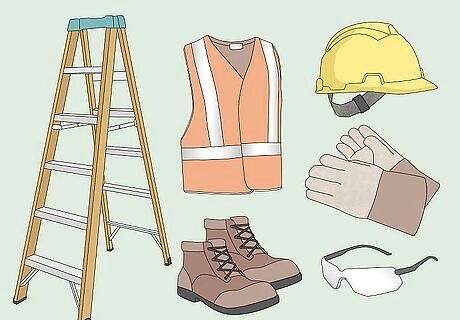
Ensure you have all the proper safety equipment. Repairing a roof can be dangerous. If you're certain you want to repair the roof instead of a professional you need to have all the appropriate equipment. A sturdy pair of boots, thick gloves, a firm ladder, protective glasses, a helmet, and a high visibility vest are all essentials.
Unrolling and Positioning the Tarp
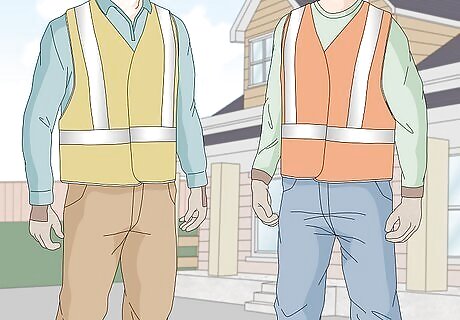
Get some friends or family to help you. If you plan on tarping your roof without a professional, you should bring some friends and family to help. Laying out a tarp can be dangerous, so it's important that you have an extra pair of hands to help with the more menial work. If you are certain you want to do it by yourself, make sure there's someone in the house that can help you if there's an emergency.

Clear all debris on the roof. If possible, wait to do this on a dry day. Bring a brush with you onto the roof. Remove all branches, leaves, and debris so that the roof is completely clear. Make sure you brush off all the leaves so that no insect life is trapped under the tarp later. If some of the branches are particularly heavy, you may need some help lifting them off your roof.

Unroll the tarp from the corners. Tarps can be unwieldy, especially on a windy day. Bring the tarp out of its packaging. It can either come folded, or as a roll. Either way, find a corner of the tarp. Once you have a firm grasp on it, have a helper grab an opposite end. As you move away from each other the tarp will naturally unroll.
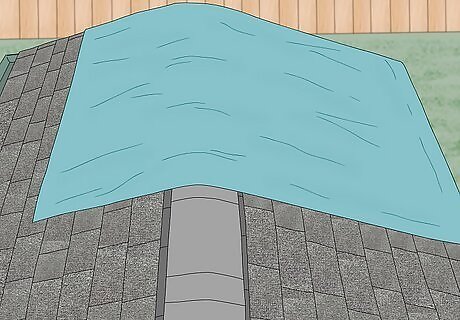
Lay the tarp out flat over the roof. Lay the tarp across the roof so that at least 4 feet (1.2 m) lies on the sloped part of your roof on each side (known as the 'Peak'). Let the rest of the tarp hang off the lower border of the roof that overhangs the wall (known as the 'Eave'). Never lay the tarp out during a storm. Never walk on the tarp.
Securing the Tarp to your Roof
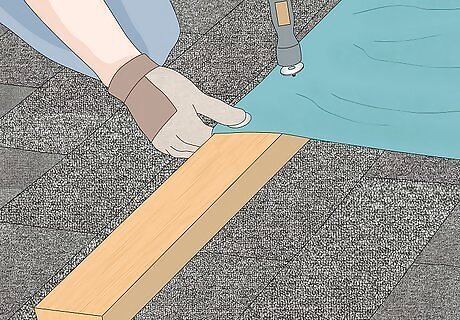
Secure 4 2x4 (38 x 89mm) boards with a drill to the peak ends of the tarp. The four edges are the peak ends. Lay a 2x4 board under one of these ends. Make sure at least 2 feet (0.61 m) sticks out to the side. Then, attach the tarp and board by hammering cap nails through the tarp and into the board underneath. Repeat this process 3 more times so that all the peak ends of the tarp have a board attached underneath them.

Wrap the tarp around the boards. Wearing a pair of carpenter's gloves, wrap the tarp around the boards underneath so they're covered on all sides. Lift the board from underneath and rotate it counter-clockwise. Once the tarp has covered all sides, lay it down on the roof again. Repeat this process for each wooden board.
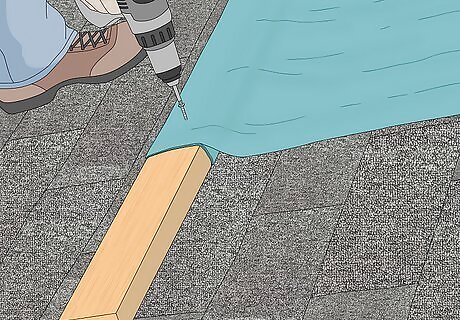
Screw through the tarp and the boards, into the roof with a drill. Choose 6 equally spaced spots on each 2x4 board. Then, with a drill, screw in 2 inches (5.1 cm) long screws. Make sure the screw goes through the tarp, then the wooden board, and into the roof. Repeat this process for all the boards. This secures the boards to the roof. Your tarp is now partly secured to withstand harsh weather.
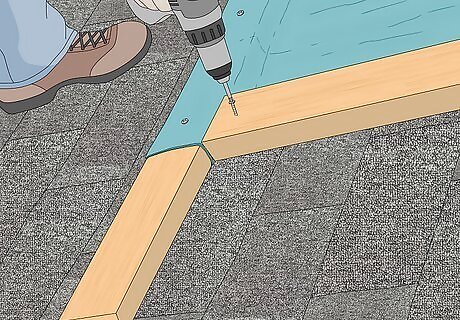
Lay 4 more 2x4 (38 x 89mm) perpendicular boards and screw them in. Lay the board flat on the roof. Place the short end of this board against the long side of the screwed in boards. Make sure the new board is over the tarp. The new board should be perpendicular to the old board. Then, choose 6 equally spaced spots on the board and screw in 2 inches (5.1 cm) screws with a drill. The screws should go through the board, then the tarp, then into the roof.

Attach 2 2x4 (38 x 89mm) boards with a drill under the overhang of the tarp. With the peak section secured, you need to secure the overhang. Bring the overhang onto the roof so you have a solid surface to work on. Then, put a 2x4 (38 x 89mm) wooden board under each side, making sure 2 feet (0.61 m) of the board is sticking out of the side. Attach the boards to the tarp by using cap nails.
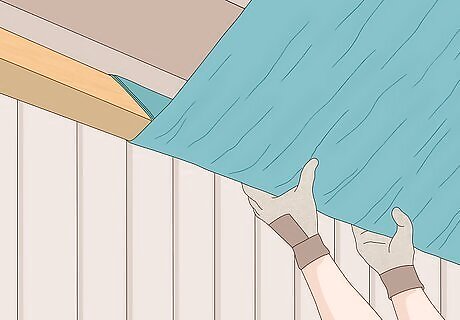
Roll the tarp's overhang under the eave and screw it in. Roll the tarp back off the eave so that it's hanging off. Then, wrap the 2x4 (38 x 89mm) wooden boards counter-clockwise so the tarp wraps around them. Place the boards tight against the base of the eave. If there's any slack in the tarp, keep wrapping the boards. Then, screw the boards and tarp into the wall using 2 inches (5.1 cm) screws.

Screw more 2x4 (38 x 89mm) wooden boards onto the tarp where necessary. The boards that are attaching the tarp to the roof are known as 'anchor boards'. If you feel that the anchor boards aren't enough to secure the tarp to the roof, or you see some areas that are loose, you should act. Lay as many 2x4 (38 x 89mm) wooden boards across the tarp as you see necessary and screw them in with 2 inches (5.1 cm) screws. This tarp is only a temporary fix to damage in the roof. Once you have applied the tarp, make plans to get a permanent fix for your roof.
















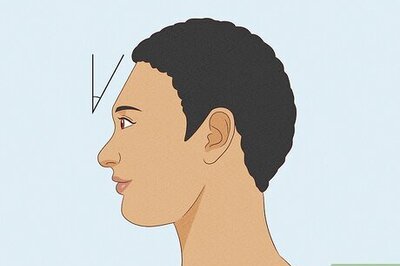


Comments
0 comment